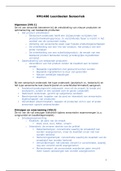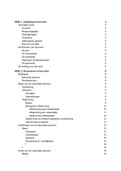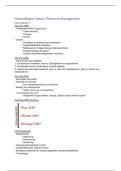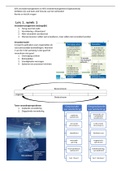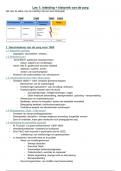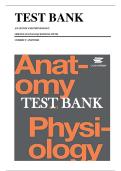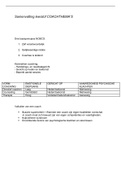These Course is structure in three macro blokes:
1. Health Inequity, 2. Measuring Inequity, 3. Assessing Efficiency in HealthCare
Lecture 1 – Production of Health
Lecture Content: Gap-minder (trends in income and health: over time, across countries and within countries); Health
production functions and the income-health relationship; Income and health growth over time: some historical
evidence; Income and health in poor countries; Income and health in rich countries.
Evidence from Gap-minder shows that:
• Income increase leads to reduction in percentage of people living with less than a dollar a day (poverty line)
38% in the 70s, 20% in 2000
• The more GDP per capita the better health status, but among OECD countries the relation is not linear
anymore (-> flat of the curve?)
• Child mortality is the best indicator for health status particularly for low health level
Some Intro:
• Health care systems aim at improving health distributions (not avarage only)
Both the level and distribution matter
• Health care is but one of many determinants (health function)
• Health and (economic) development are related
• Measurement of marginal health product of health care and income is hampered by (problems of):
o Population health measurement
o Estimation of marginal contribution ≠ total contribution
o Reverse causality and confounding
Health Production Function
Population health = f(health care, lifestyle,schooling, environment, human biology, genes, …)
There is Diminishing returns to scale; wherefore there is
marginal product of health investments decreases, and
decreasing marginal benefit per incresing unit (Flat-of-the-curve medicine?)
Moreover, it is difficult to assess whether it is Correlation or causality? If there is Reverse? Or it is Spuriousus?
(causal effect vs associatio)
Health and Development
Health improvements have pushed fro important demographic changes:
• Mortality effect (longer lives) and fertility effect (fewer births) leads to age-structure shift
▪ Mortality decreased due to technological progress
▪ Fertility decreased due to behavioural change
These factors lead to:
Simultaneus effect in High-income countries, with a consequent (up to) 2% population growth
Adoption of new technologies faster than behavioural shift In developing countries, (up to) 4% pop. growth
Together with Demographic transition, also Epidemiological Transition:
• Expensive diseases drive out cheap diseases
• Relative increase in old-age diseases
,Throughout History the major determinants of mortality decline were:
1. Improved nutrition
o Half of all mortality decline in late eighteenth century due to increased caloric intake and growth in
height (RW Fogel, Escape from hunger and premature death, 2004)
2. Public health
o Water and food borne diseases (Preston). Water purification explains half of mortality reduction in
start of 20th century US: 23 to 1 rate of return! (Cutler and Miller, Demography, 2005)
3. Vaccinations
o Many declines in infection disease mortality occurred before introduction of effective vaccines due
to sanitation and public health measures (Mc Keown (criticism), 1976, The modern rise of population)
4. Medical treatment
o Two-thirds of cardiovascular mortality decline due to medical advances (Cutler, Your money or your
life, 2004)
Public Health and Sanitation measures represented a cheap and very effective in reducing Mortality
Therefore, the Historical Evidence shows mainly 3 phases:
Phase 1 (app 1750-1850): nutrition (with economic growth)
Phase 2 (app 1850-1930): public health, mainly cleaner water in cities and better sanitation
Phase 3 (1930-2000): medical care, first vaccines and antibiotics, later ‘big medicine’
Countries’ life expectancies “Converge and Diverge” in different periods,
Clear Large disparities
Convergence. Up until about 1980, life expectancies were converging across countries. Convergence here is defined as a
reduction in a measure of spread, such as the standard deviation of life expectancies. Life expectancy is taken to be the same
for everyone in a country. After 1980, this convergence slowed and then reversed. Life expectancies were similar around the
world until about 1750, or even later.
Starting in the 18th century, life expectancy began to increase in Britain, followed by the countries of Northwest Europe, and
North America. As was the case with incomes per capita, the industrial revolution, this led to a “great divergence” across
countries. The countries of southern and eastern Europe were next, in the first half of the 20th century, and finally, after 1945,
the countries of the third world. They
experienced extraordinarily rapid increases in life expectancy, sometimes gaining more than two years of life expectancy in a
single calendar year. This catching up generated the modern convergence of life expectancy, until about 1990. The
convergence was fueled by the transmission from the first to the third world of technologies of disease control based on the
germ theory of disease. The divergence after 1980 was in part a consequence of the collapse in life expectancy in the transition
countries of Eastern Europe, but even more was a consequence of the HIV/AIDS epidemic in sub-Saharan Africa.
Income and Health Relationship in poor(er) countries:
There is a very strong association, but what does it mean for policy? That one has to await income growth and
development for improved population health? Or that they go hand in hand for other (unobserved) reasons? (if yes,
is it an association or causal effect) Does all income growth result in better health?
In other words: is wealthier always healthier? Let’s look at some evidence from Econometric Analysis…
Income and Health Linkages: Strong positive cross-sectional association income-health long observed since Preston
• E.g. Gertler and van der Gaag (1990) found that 10% increase in GNP/cap, on average, associated with:
8 extra year of life expectancy; 8.3% lower infant (<1y) mortality rate; 14.2% lower child (<5y)
mortality rate; and 1.5% lower crude death rate (remember though that association is not causality)
, Consequently, Concave structural relationship has shifted
upward over last century (graph). The authors argue for a
STRUCTURAL SHIFT. Why? Because:
Technological improvements make health production
cheaper (namely, medical progress and tachnological
advances)
and
Preference shift towards health (medicalization)
But, how does Income generate health?
Not directly, cannot buy health, but can use income for health-enhancing or other goods and services, which can
also be harmful (e.g. smoking, obesity)
The Concave relationship (in Preston Curve, the one above) means that average life expectancy (LE) across incomes
is lower than life expectancy of those with average incomes (Jensen’s inequality). And shows that gains are smaller
at hgher income levels ( flat of the curve).
The Emprirical analysis of income-health reationship shows a relatively low marginal productivity of income at
aggregate level.
Kakwani model:
hi log(yi ) i alpha? Country-specific fixed effect?
Strong positive income elasticities of population health, but falling with rising income however β is not significant.
However, Anand & Ravallion (22 LDCs, 1993) included a factor (zi)
(they analyzed one year only statistic relationship):
Anand & Ravallion Model:
hi log(yi ) zi i
“When controlling for other (zi) factors, in particular the poverty rate and public health expenditure per capita,
income becomes insignificant (β=0, not rejected)”.
Pritchett & Summers (1993, Wealthier is healthier), they performed a Panel data analysis of 60 dev countries, period
1960-1985 (dinamic), inf and child mortality The model is
Pritchett & Summers Model:
hit i log(yit ) xit t i Used!
This model: i = country and t = time; hit: health status (namely infant mortality, life exp.)
• Allows for Country-specific fixed effects (αi; i=1,…,60) represents: reigion, country structure, observing
country over time to assess which are the fixed effects
• Allows for Time-specific effects (δt; t=1960, …,1985) represents: elements that overall (in all country) change
over time and are specific to a certain time.
• Uses Instrumental Variables for income growth (in the β Log) indicates terms of trade (=exports/imports)
GDP per capita, that does not directly influence health It is used to Predict variation in income and Takes
out reverse causality
• Accounts for (x) othe variables of the health production function such as schooling, housing, etc.
“The authors found a LT causal income elasticity of infant mortality -0.2 and of child mortality -0.4 (10% increase in
income lead to 2 % reduction of mortality and 4% reduction in child mortality). Therefore, they found that more than
half million deaths in 1990 were due to poor economic performance in 1980s.”
To make Causation claims we need a well defined and structured model that takes into account several variables



